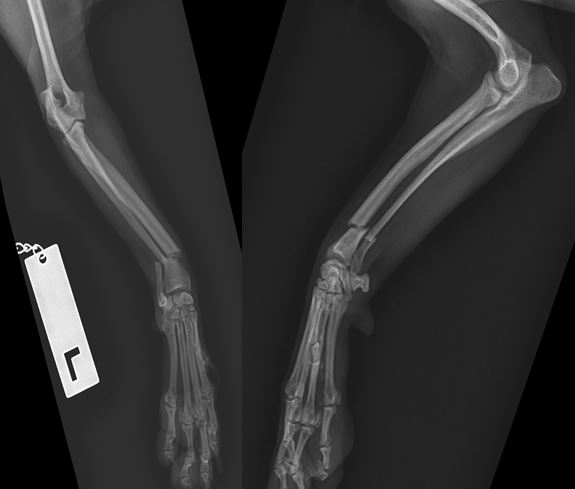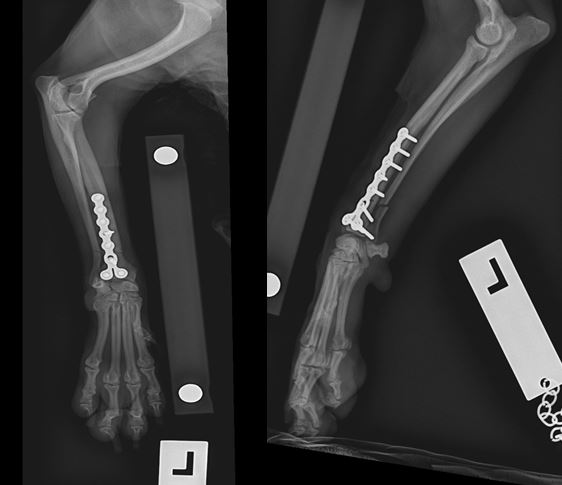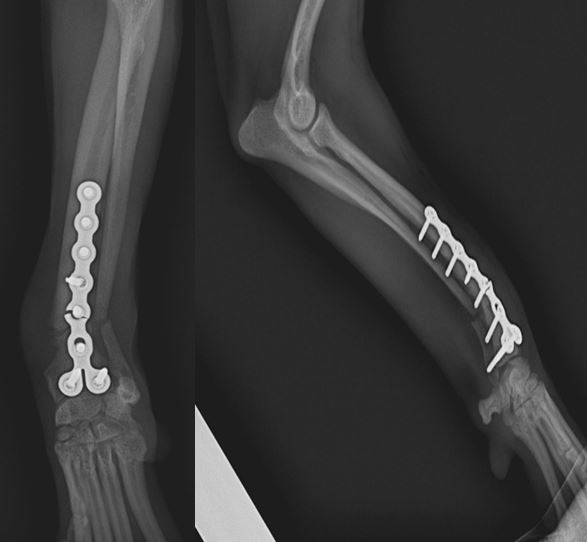Are you confident in your practice to repair challenging fractures in toy breeds and cats?

With the increased popularity of toy breeds, presentations of challenging fractures to veterinarians are becoming more frequent, and the skills specific to these cases are not taught at university.
The following case study, provided by Dr Penny Tisdall, a highly experienced small animal specialist surgeon, demonstrates some of the complications that might arise when repairing fractures in toy breed dogs.
Sootie is a 3.5-year-old female neutered Maltese cross. She presented with a non-weight bearing lameness of her left forelimb, with a history of the owner having stood on her foot that morning.
Initial radiographs show a short oblique fracture of the radius and ulna with a short distal fragment.

Surgery was performed using a 1.5 mm locking T plate (Synthes). The fracture ends were well aligned, and repair allowed some load sharing although the fracture was not compressed. In this application the 3rd distal screw was cortical rather than locking due to the proximity of the fracture line. All screw holes were filled in the proximal fragment in this case, although theoretically there may be no advantage to using more than 3-4 screws.

Sootie was discharged with a soft bandage support for 10 days, and prescribed Carprofen for 10 days and transdermal fentanyl for 3 days. The owners were advised to limit Sootie’s activity by using cage style rest with leashed toilet breaks.
Sootie was reviewed 2 weeks post op and showed excellent clinical function. Her sutures and the padded dressing were removed. The owners were advised to continue strict rest for Sootie.
4 weeks post op Sootie presented with an acute onset of recurrent non-weight bearing left forelimb lameness; the owners reported that she had been confined but that she jumped around in the crate. Repeat radiographs show a plate fracture.

Potential reasons for plate failure include:
1.Plate fatigue
-The 1.5 mm locking bone plate is thin but was considered an appropriate implant for a dog of this size; implant choice was constrained by available implant selection, bone size and presence of a short distal fragment. A short working length of the plate by placing three screws distally and filling all available screw holes may have concentrated stress at the fracture site and on the implant. This is called stress concentration. Ideally locking plate fixation relies more on the principles of elastic plate osteosynthesis where longer less rigid fixation is used. This distributes stress over the length of the implant.
-Excessive activity? The owner denied that Sootie had been excessively active.
-Relatively delayed healing? There was reasonable biology in this dog and minimal trauma to cause fracture, however in toy breed dogs there may be reduced bloody supply to the distal radius.
2.Non-compression
This was used because of the fracture configuration, and the implant limitation of only one dynamic compression plate site.
3.Screw Density and Position
May lead to stress concentration in the plate.
Secondary surgical repair and revision was undertaken. The T plate was replaced using new screws and the same screw holes. The principal of “open but do not touch” was used; this aims to limit disruption to soft tissues and blood supply by use of minimal handling and tissue disruption. A 4-hole 1.5 mm ulna locking compression plate was applied to the ulna with cortical screws to protect the plate and an autogenous cancellous bone graft was performed; this was collected from the ipsilateral humerus. Consideration could have been given to reducing the number of plate screw holes that were filled around the fracture site to reduce stress concentration.

At follow up, Sootie showed good clinical progress at 5 weeks. This case demonstrates that when using locking plates we need to understand that the principals of fixation are not identical to those we have established using dynamic compression plates.

With the rising ownership of smaller pets in Australia, VetPrac is offering a course specifically focused on surgery in toy breeds and cats, and is delighted to welcome back Penny as a supporting tutor at this workshop. Led by Dr Stanley Kim with Dr Peter Young and Dr James King also supporting, Penny will share her vast experience in the surgical repair of fractures in our smaller patients at the Fine and Fiddly Fractures Workshop at Gatton on April 12-13, 2019.
The focus will be on the practical considerations for trauma in small breed dogs and cats, and the purpose designed instrumentation and equipment required. Practical sessions will allow workshop attendees to perform surgical repairs of commonly seen complex fractures of toy breeds, such as the distal radial fracture like Sootie’s, and humeral condylar fractures, in a safe, supportive, fun and friendly environment.
To register for this amazing workshop, head here. For more information, check out the brochure.
